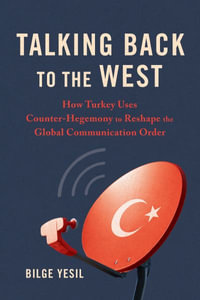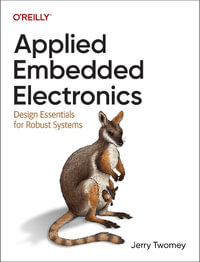
Interference Mitigation in Device-to-Device Communications
By: Masood Ur Rehman (Editor), Ghazanfar Ali Safdar (Editor), Mohammad Asad Rehman Chaudhry (Editor)
Hardcover | 8 March 2022 | Edition Number 1
At a Glance
240 Pages
24.4 x 17.0 x 1.9
Hardcover
RRP $265.05
$218.80
17%OFF
or 4 interest-free payments of $54.70 with
orAims to ship in 7 to 10 business days
Interference Mitigation in Device-to-Device Communications delivers a thorough discussion of device-to-device (D2D) and machine-to-machine (M2M) communications as solutions to the proliferation of ever more data hungry devices being attached to wireless networks. The book explores the use of D2D and M2M technologies as a key enabling component of 5G networks. It brings together a multidisciplinary team of contributors in fields like wireless communications, signal processing, and antenna design.
The distinguished editors have compiled a collection of resources that practically and accessibly address issues in the development, integration, and enhancement of D2D systems to create an interference-free network. This book explores the complications posed by the restriction of device form-factors and the co-location of several electronic components in a small space, as well as the proximity of legacy systems operating in similar frequency bands.
Readers will also benefit from the inclusion of:
- A thorough introduction to device-to-device communication, including its history and development over the last decade, network architecture, standardization issues, and regulatory and licensing hurdles
- An exploration of interference mitigation in device-to-device communication underlaying LTE-A networks
- A rethinking of device-to-device interference mitigation, including discussions of the challenges posed by the proliferation of devices
- An analysis of user pairing for energy efficient device-to-device content dissemination
About the Editors
Masood Ur Rehman, PhD, is a Lecturer in Electronic and Nanoscale Engineering at the University of Glasgow, UK. He is a Fellow of the Higher Education Academy UK, Senior Member of the IEEE, and Associate Editor of the IEEE Access, IEEE Antennas & Wireless Propagation Letters, Microwave & Optical Technology Letters and IET Electronics Letters.
Ghazanfar Ali Safdar, PhD, is a Senior Lecturer in Computer Networking at the University of Bedfordshire, UK. He is Associate Fellow of Higher Education Academy, UK. He was an R&D Engineer with Carrier Telephone Industries and Schlumberger, France. Dr. Safdar is Editor-in-Chief of EAI Endorsed Transactions on Energy Web and Information Technology, Area Editor of Springer Wireless Networks and Topic Editor of MDPI JSAN.
Mohammad Asad Rehman Chaudhry, PhD, MBA,is a thought-leader, innovator and entrepreneur leading multi-disciplinary projects in Digital Disruption and Future-Tech. He has developed strategy recommendations for Fortune 500. Dr. Chaudhry also leads IEEE Standards in Software-Defined and Virtualized Ecosystems.
Preface xiii
Acknowledgments xv
About the Editors xvii
List of Contributors xix
1 Introduction to D2D Communications 1
Ghazanfar Ali Safdar, Masood Ur Rehman, and Mohammad Asad Rehman Chaudhry
1.1 D2D Communication 1
1.2 Evolution of D2D Communication 3
1.3 D2D Communication in Cellular Spectrum 6
1.4 Classification of D2D Communication 9
1.5 Challenges in D2D Implementation 10
1.6 Summary 11
References 11
2 Interference Mitigation in D2D Communication Underlaying LTE-A Network 13
Ghazanfar Ali Safdar, Masood Ur Rehman, Mujahid Muhammad, and Muhammad A. Imran
2.1 Applicability of D2D Communication 15
2.2 Interference – The Compelling Issue in D2D 17
2.3 Types of D2D Communication 17
2.3.1 In-Band D2D Communication 18
2.3.1.1 Underlay In-Band 18
2.3.1.2 Overlay In-Band 19
2.3.2 Out-Band D2D Communication 19
2.3.2.1 Network-Assisted D2D Communication 21
2.3.2.2 Autonomous D2D Communication 22
2.4 D2D Communication Underlaying Cellular Network – The Challenges 23
2.4.1 Device Discovery 24
2.4.2 Mode Selection 25
2.4.3 Radio Resource Management 25
2.4.4 Modification to LTE-A Architecture 27
2.4.5 Security in D2D 27
2.4.6 Mobility Management 28
2.5 Interference in D2D 28
2.5.1 Power Control Techniques 31
2.5.2 Radio Resource Allocation Techniques 32
2.5.3 Joint Power Control and Radio Resource Allocation Techniques 33
2.5.4 Spectrum Splitting Techniques 34
2.5.5 Other Interference Mitigation Techniques 34
2.5.6 Multiple-Input Multiple-Output Techniques 35
2.5.7 Comparative Analysis of D2D Interference Mitigation Techniques 39
2.6 Summary 42
References 42
3 Rethinking D2D Interference: Beyond the Past 49
Mohammad Asad Rehman Chaudhry and Zakia Asad
3.1 Interference Manipulation 49
3.1.1 Example 50
3.2 Formulation of Interference Manipulation Problem 52
3.3 Matrix Rank Minimization: A Way to Manipulate Interference 53
3.3.1 Reduction of Interference Manipulation to Matrix Rank Minimization 53
3.3.2 Minimum Rank Matrix to Transmission Scheme 54
3.3.3 Does the Field Size Matter? 55
3.4 Interference Manipulation: A Boolean Satisfiability Approach 55
3.5 Interference Manipulation: Index Coding Perspective 56
3.5.1 Interference Manipulation Is NP-hard 57
3.5.2 An Efficient Solution for Interference Manipulation 58
3.6 Summary 60
References 60
4 User Pairing Scheme for Efficient D2D Content Delivery in Cellular Networks 63
Yanli Xu
4.1 D2D Content Delivery 63
4.2 D2D Content Delivery Architecture 65
4.2.1 Network Model 65
4.2.2 Channel Model 66
4.2.3 Content Delivery Model 66
4.3 D2D Content Delivery Strategies 67
4.3.1 Pairing Range 67
4.3.2 Energy Efficiency for Multicast and Unicast 72
4.3.3 Caching and Delivery 73
4.4 D2D Delivery Mode Selection 75
4.5 Performance Evaluation 77
4.6 Summary 84
References 84
5 Resource Allocation for NOMA-based D2D Systems Coexisting with Cellular Networks 89
Tien H. Nguyen, Taehyun Yoon, Xuan T. Nguyen, Daeseung Yoo, Byungtae Jang, and Van D. Nguyen
5.1 NOMA-based D2D Systems 90
5.2 System Model and Performance Analysis 91
5.2.1 System Model and Assumptions 91
5.2.2 Capacity Analysis of D2D and Cellular Networks 92
5.2.2.1 Uplink Cellular Networks Transmission 92
5.2.2.2 Downlink NOMA-D2D Transmission 93
5.3 Joint Subchannel Assignment and Power Control for D2D Communication 95
5.3.1 Subchannel Assignment Scheme 96
5.3.2 Power Control Scheme 97
5.4 Optimization of D2D Device Pairing 99
5.5 Results and Discussion 100
5.5.1 Channel Model 101
5.5.2 Performance Evaluation 102
5.6 Summary 105
References 105
6 Distributed Multi-Agent RL-Based Autonomous Spectrum Allocation in D2D-Enabled Multi-Tier HetNets 109
Kamran Zia, Nauman Javed, Muhammad N. Sial, Sohail Ahmed, Asad A. Pirzada, and Farrukh Pervez
6.1 D2D Resource Allocation Methods 110
6.2 Reinforcement Q-Learning 113
6.3 System Model 114
6.4 Resource Allocation in Multi-tier D2D Communication 116
6.4.1 Autonomous Spectrum Allocation Scheme 118
6.5 Performance Evaluation 119
6.5.1 Performance of D2D Users 121
6.5.2 Performance of Cellular Users 122
6.5.3 Coverage Analysis 125
6.5.4 Computational Time Analysis 125
6.5.5 Memory Requirements 127
6.5.6 Effect of Base Stations Density 128
6.5.7 Effect of Network Tiers 129
6.6 Summary 130
References 130
7 Adaptive Interference Aware Device-to-Device-Enabled Unmanned Aerial Vehicle Communications 133
Navuday Sharma, Rafay I. Ansari, Rida Khan, Hassan Malik, and Haris Pervaiz
7.1 Key Elements in D2D Communication 134
7.1.1 D2D Network Discovery 135
7.1.2 SWIPT for D2D 135
7.1.3 Resource Allocation 136
7.1.4 3GPP Standardization 136
7.2 Unmanned Aerial Vehicles in D2D 137
7.2.1 Key Challenges in UAV-based D2D 139
7.2.2 Transmission over PC5 Interface for UAV-based D2D Discovery 140
7.2.3 Interference in UAV-based D2D 141
7.3 Summary 144
References 144
8 Emergency Device-to-Device Communication: Applicability, Case Studies and Interference Mitigation 149
Imran Haider, Mohsin Raza, Kamran Ali, Muhammad Awais, Vishnu V. Paranthaman, and Muhammad Y. M. Mirza
8.1 Emergency D2D Communication 150
8.2 Approaches for Efficient Emergency D2D Communication 152
8.3 Emergency D2D Communication: Case Studies 155
8.4 Interference Mitigation in Emergency D2D Communication 158
8.4.1 Radiated Power Management 159
8.4.2 Frequency Allocation 160
8.4.2.1 Hybrid Schemes for Power Control and Intelligent Frequency Allocation 160
8.4.3 Time Division Multiplexing (TDM) 161
8.4.4 Adjacent Channel Interference Cancellation in DSRC 161
8.4.5 Interference Mitigation through Multiple Antennas (MIMO) 162
8.4.5.1 Beam Steering in 3GPP 5G NR Supported Vehicular Systems 162
8.5 Summary 164
References 164
9 Disaster Management Using D2D Communication With Power Transfer and Clustering Techniques 167
Kamran Ali, Huan Nguyen, Aboubaker Lasebae, Anum Tanveer, Purav Shah, Mohsin Raza, Bushrah Naeem, and Tahera Kalsoom
9.1 D2D Communication in Disaster Management 168
9.2 D2D Communication in Disaster Management: Key Considerations 169
9.3 D2D Disaster Management System Architecture 171
9.3.1 Time Switching-Based Protocol 172
9.3.2 Network Configuration 173
9.3.3 Outage Probability for Mode Selection 174
9.4 Power Transfer Using Relaying and Clustering in D2D Disaster Management 178
9.4.1 System Model 178
9.4.2 Performance Evaluation 179
9.4.2.1 Energy Calculation 179
9.5 Results and Discussion 182
9.6 Summary 187
References 188
10 Road Ahead for D2D Communications 191
Masood Ur Rehman, Ghazanfar Ali Safdar, and Mohammad Asad Rehman Chaudhry
10.1 Future Prospects and Challenges 191
10.1.1 Spectrum Sharing and Coexistence 192
10.1.2 Standardization 192
10.1.3 Secure Communication 193
10.1.4 Energy Consumption and Energy Harvesting 194
10.1.5 Interference Management 195
10.1.6 Resource Allocation 196
10.1.7 Device Discovery 197
10.1.8 Handover 198
10.1.9 Network Slicing 198
10.1.10 D2D in Vehicular Communications 199
10.1.11 D2D in Disaster Management 199
10.1.12 D2D at Millimeter Wave Frequencies 199
10.1.13 D2D and Social Networks 200
10.1.14 D2D and Visible Light Communication (VLC) 200
References 201
Index 207
ISBN: 9781119788799
ISBN-10: 111978879X
Published: 8th March 2022
Format: Hardcover
Language: English
Number of Pages: 240
Audience: Professional and Scholarly
Publisher: John Wiley & Sons (UK)
Country of Publication: US
Edition Number: 1
Dimensions (cm): 24.4 x 17.0 x 1.9
Weight (kg): 0.57
Shipping
| Standard Shipping | Express Shipping | |
|---|---|---|
| Metro postcodes: | $9.99 | $14.95 |
| Regional postcodes: | $9.99 | $14.95 |
| Rural postcodes: | $9.99 | $14.95 |
How to return your order
At Booktopia, we offer hassle-free returns in accordance with our returns policy. If you wish to return an item, please get in touch with Booktopia Customer Care.
Additional postage charges may be applicable.
Defective items
If there is a problem with any of the items received for your order then the Booktopia Customer Care team is ready to assist you.
For more info please visit our Help Centre.
You Can Find This Book In

INCOSE Systems Engineering Handbook
5th Edition - A Guide for System Life Cycle Processes and Activities
Paperback
RRP $149.95
$92.50
OFF






















